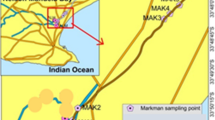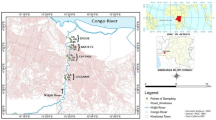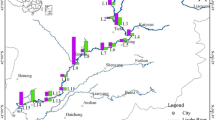Abstract
The Spatio-temporal variability of the Seine River contamination by organic micropollutants such as Polybrominated diphenyl ethers (PBDEs) was investigated in three sites downstream and upstream of Paris between February and November 2010. The mean concentrations of Σ tri-hepta BDE observed at Marnay-Sur-Seine (upstream Paris) are 2.7 times lower than those measured at Bougival-Sur-Seine (downstream Paris), while this ratio is equal to 1.8 for BDE-209. Besides, close concentrations are observed at both downstream sites. The concentration gradient was also observed for PBDE concentrations in sediments collected with particle traps. The PBDE temporal evolution was related to particulate organic matter content which is controlled by river flow variations between February to November. The variation in fluxes of these pollutants seems to result from a regular contribution (case of Bougival and Triel-Sur-Seine) and of a diffuse contribution, case of Marnay-Sur-Seine.
Access provided by Autonomous University of Puebla. Download conference paper PDF
Similar content being viewed by others
Keywords
1 Introduction
Polybrominated diphenyl ethers (PBDEs) have been widely used in the past decades in many industrial applications. PBDEs are used as additives to prevent fire and constitute a significant class of brominated fire retardants (BFRs). Historically, three major commercial formulation PBDEs have been produced: Penta-BDE, octa-BDE, and deca-BDE. The latter is the only one still allowed in the European Union (EU) after the other formulations were phased out (BSEF 2019). These pollutants, qualified as ubiquitous, have been detected in biotic and abiotic compartments, among others, in river water samples (Carroll et al. 2008). PBDEs have been identified as endocrine disruptors in vivo and in vitro (Darnerud et al. 2001). Surface waters are often considered as an essential compartment for the transport of organic and inorganic micropollutants, especially in urban areas, which are significant emissions areas of anthropogenic pollutants (Lee et al. 2004; Braekevelt et al. 2003). Organic pollutant transport by surface waters is controlled by the hydrological cycle and sorption onto suspended particles matter (SPM) and may also be partly controlled by water characteristics (pH, dissolved organic carbon (DOC), the concentration of essential cations). The aim here is to study the Spatio-temporal variability of the Seine water contamination by organic micropollutants such as PBDEs. PBDE levels were investigated in Seine River under different hydrological conditions (high flows in autumn/winter and lower flows in the spring/summer). The choice of the three sites on the upstream or the downstream of the Paris agglomeration allows apprehending the impact of the Parisian urbanization on the quality of aquatic receiving environments. According to Tlili et al. (2011), the Seine basin (approximately 78,650 km2) is heavily impacted by anthropogenic activities; indeed this river receives vast amounts of urban stormwater overflows and wastewater treatment plant (WWTP) effluents.
2 Materials and Methods
A monthly monitoring of PBDE concentrations was performed on three stations (Fig. 1), representatives of environments under different anthropogenic pressures, upstream (Marnay-Sur-Seine) and downstream of the Paris agglomeration (Bougival and Triel-sur-Seine).
Between February and November 2010, water samples were taken from these three stations. In addition, stainless steel particle traps (height: 25 cm, \(\emptyset\): 15 cm) were also installed at each station, sampling is carried out one time for a period of three months. SPM, DOC, and all samples (water and sediments) were processed as described in Labadie et al. (2010). Statistical differences were evaluated by Mann–Whitney test (XLSTAT PRO software; Copyright holder CC-BY-SA-3.0, Addinsoft, Paris, France).
3 Results
3.1 Hydrological Conditions
The Seine's hydrological cycle is characterized by high flows in autumn/winter and lower flows in the spring/summer. On the Triel-Sur-Seine site located downstream from the confluence of the Yonne, Marne, and Oise, the high water flows (February, March, October, and November) are the highest (from 300 to 600 m3 s−1, (DIREN)). For the period from mid-April to the beginning of September, flows were about 200 m3 s−1 (DIREN), which have been observed. The lowest ones are noted for June and July campaigns (90–110 m3 s−1 (DIREN) at Bougival and 160–190 m3 s−1 (DIREN) at Triel-Sur-Seine).
DOC analyzes were also performed for each campaign. Mean concentrations were estimated at 2.1 ± 0.2 mg L−1 for Marnay, 2.9 ± 0.4 mg L−1 for Bougival and 3.5 ± 0.3 mg L−1 for Triel-Sur-Seine.
3.2 Spatio-temporal Variation of Contamination Levels
Figure 2 illustrates the concentrations of ∑ tri-hepta PBDEs and BDE-209 (ng L−1) for the sites of Marnay-Sur-Seine, Bougival and Triel sur-Seine.
The comparison of the concentrations between the upstream (Marnay-Sur-Seine) and downstream (Bougival and Triel-Sur-Seine) sites show a marked concentration gradient. The mean Σ tri-hepta PBDE concentrations observed at Marnay-Sur-Seine are 2.7 times lower than those measured at Bougival-Sur-Seine, while this ratio is equal to 1.8 for BDE-209.
The temporal trend of PBDE concentrations in the water and sediments of the Seine River may be due to the temporal flow variation of the Seine (increases in the winter period and decreases in the summer period) which induces the SPM variation and consequently the PBDE intake associated with these particles. This result confirms our previous findings (Tlili et al. 2011).
The concentration gradient was also observed for PBDE concentrations in sediments collected with particle traps (Fig. 3). In Bougival, the PBDE content is 181 ng g−1 organic carbon (OC) for ∑ tri-hepta PBDEs and 1741 ng g−1 OC for BDE-209. These levels are 5times higher than those determined at Triel (∑ tri-hepta PBDEs: 34 ng g−1 OC and BDE-209: 381 ng g−1 OC) and 16 times higher than those observed in Marnay-Sur-Seine (∑ tri-hepta PBDEs: 11 ng g−1 OC and BDE-209: 89 ng g−1 OC).
4 Discussion
Statistically, the difference between PBDE concentrations in upstream and downstream sites, both for the Σ tri-hepta PBDEs and the BDE-209, is not significant (p > 0.05, Mann–Whitney). This result is probably due to the limited number of samples (n = 9). Besides, the importance of the concentrations observed in Bougival-Sur-Seine compared to those of Triel-Sur-Seine may result from PBDE inputs associated with several local sources near to the Bougival station, including the port of Gennevilliers, the urban runoff at the Clichy and Briche, and the WWTP Seine Center. Significant concentrations were observed for all PBDEs in the samples from the two downstream stations in September 2010. Such a result is probably related to the contributions associated with urban runoff (Clichy and Briche). The study of temporal variability and dynamics of PBDEs according to water conditions (high flows in autumn/winter and lower flows in the spring/summer) shows a different behavior compared to the observations made in the center of Paris in a previous study (Tlili et al. 2011).
5 Conclusion
This work enabled us to confirm the presence of PBDEs in the surface waters of the Seine, both in areas under heavy anthropogenic pressure and in reference areas. The Spatio-temporal monitoring of PBDE contamination reveals a significant impact of the Paris agglomeration on measured concentrations, with a strong upstream/downstream gradient. PBDEs are nevertheless detected at the reference station at low levels. The upstream zone appears relatively contaminated, considering the anthropic pressure to which it seems to be subject.
References
BSEF Bromine Science and Environnemental Forum. http://www.bsef.com. Last Accessed 14 June 2019
Braekevelt, E., Tittlemier, S.A., Tomy, G.T.: Direct measurement of octanol-water partition coefficients of some environmentally relevant brominated diphenyl ether congeners. Chemosphere 51, 563 (2003)
Carroll, J., Savinov, V., Savinova, T., Dahle, S., McCrea, R., Muir, D.C.G.: PCBs, PBDEs and pesticides released to the Arctic Ocean by the Russian Rivers Ob and Yenisei. Environ. Sci. Technol. 42, 69–74 (2008)
Darnerud, P.O., Eriksen, G.S., Jóhannesson, T., Larsen, P.B., Viluksela, M.: Polybrominated diphenyl ethers: occurrence, dietary exposure, and toxicology. Environ. Health Perspect. 109, 49–68 (2001)
DIREN: Directions Régionales de l'Environnement. http://www.ile-de-france.ecologie.gouv.fr/
Lee, R.G.M., Thomas, G.O., Jones, K.C.: PBDEs in the atmosphere of three locations in Western Europe. Environ. Sci. Technol. 38, 699–706 (2004)
Labadie, P., Tlili, K., Alliot, F., Bourges, C., Desportes, A., Chevreuil, M.: Development of analytical procedures for trace-level determination of polybrominated diphenyl ethers and tetrabromobisphenol A in river water and sediment. Anal. Bioanal. Chem. 396, 865–875 (2010)
Tlili, K., Labadie, P., Alliot, F., Bourges, C., Desportes, A., Chevreuil, M.: Influence of Hydrological Parameters on Organohalogenated Micropollutant (Polybrominated Diphenyl Ethers and Polychlorinated Biphenyls) Behaviour in the Seine (France). Arch. Environ. Contam. Toxicol. 62, 570–578 (2011)
Author information
Authors and Affiliations
Corresponding author
Editor information
Editors and Affiliations
Rights and permissions
Copyright information
© 2022 The Author(s), under exclusive license to Springer Nature Switzerland AG
About this paper
Cite this paper
Tlili, K. et al. (2022). Organohalogenated Micropollutants: Polybrominated Disphenyl Ether (PBDE) Contamination Gradient of the Seine River in France. In: Chenchouni, H., et al. New Prospects in Environmental Geosciences and Hydrogeosciences. CAJG 2019. Advances in Science, Technology & Innovation. Springer, Cham. https://doi.org/10.1007/978-3-030-72543-3_52
Download citation
DOI: https://doi.org/10.1007/978-3-030-72543-3_52
Published:
Publisher Name: Springer, Cham
Print ISBN: 978-3-030-72542-6
Online ISBN: 978-3-030-72543-3
eBook Packages: Earth and Environmental ScienceEarth and Environmental Science (R0)







